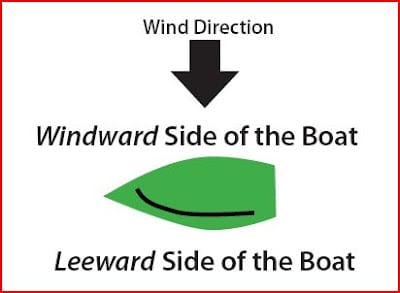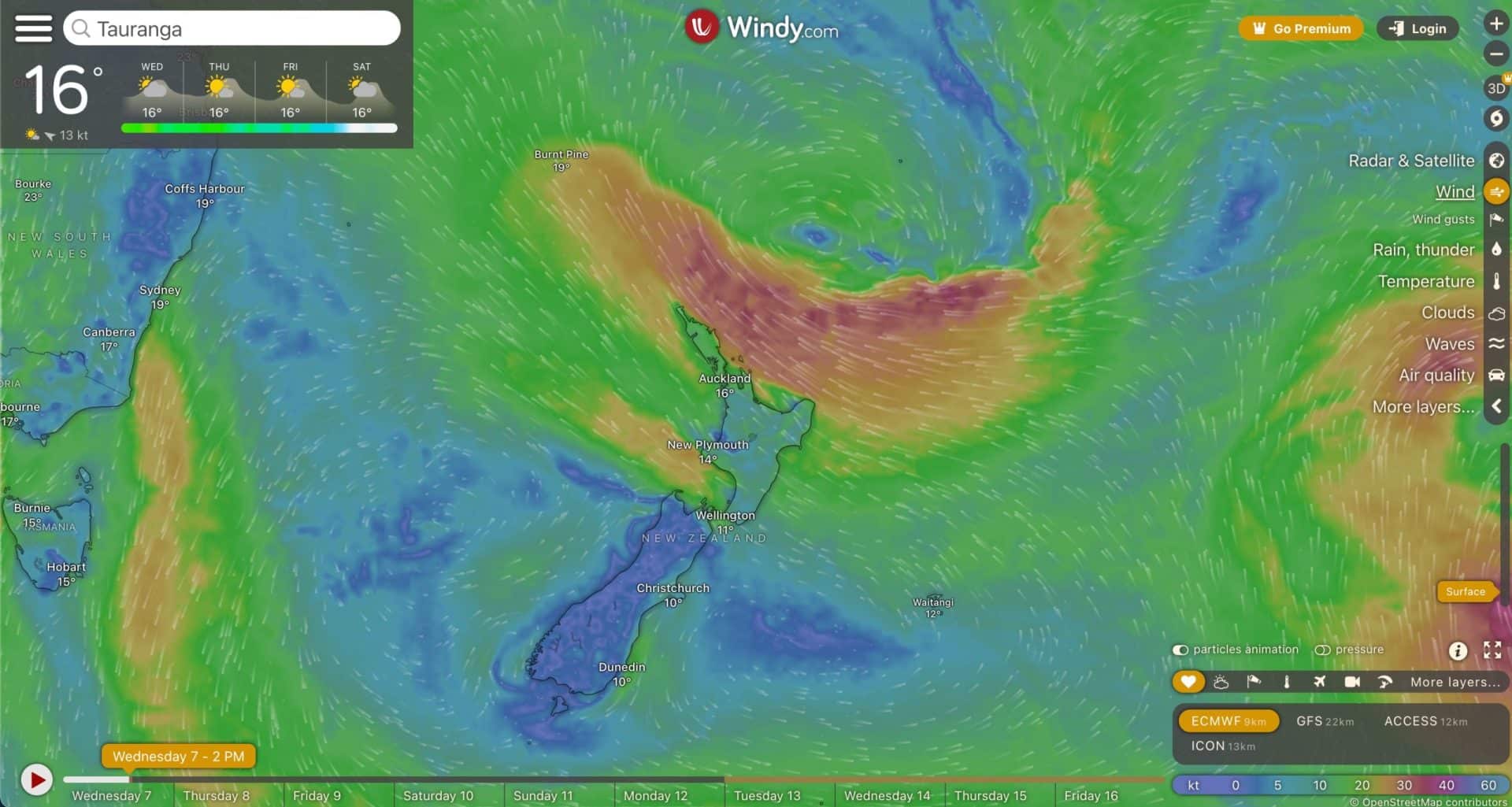Let’s delve into some basic terminologies related to wind and fishing. The terms’ onshore’ and ‘offshore’ probably ring a bell, even if you’ve been too nervous to ask what they mean until now. But fear not! Here’s an understandable explanation for both.
A sea breeze or onshore breeze is any wind that blows from a large body of water toward or onto a landmass. By contrast, a land breeze or offshore breeze is any wind that blows from a landmass toward or onto a large body of water.

Onshore Wind (Sea Breeze)
Now, let’s explore the concept of onshore winds, also known as a sea breeze. The term sounds complicated, but it’s pretty simple.
Onshore wind is the wind that blows from the sea towards the land. This wind happens mainly during the day when the sun heats land faster than the sea. Imagine standing on the beach facing the sea; if the breeze hits you straight in the face, that’s an onshore wind.
Impact of the Onshore Wind on Fish Behaviour
When we have an onshore wind, it’s effectively pushing surface water away from the coast, which can significantly affect fishing. It often results in upwelling, where colder water from the depths replaces the surface water blown away by the wind.
You see, this cold, deep water is typically rich in nutrients. So, its movement towards the surface results in a surge of marine life, attracting baitfish and, consequently, larger predatory fish. It’s like ringing the dinner bell for fish!
Landbased Fishing in Onshore Wind Conditions
Now you understand the basics of onshore wind and how it affects fish behaviour, but how about casting your line in these conditions?
Generally, onshore wind is considered favourable for shore fishing. As the wind blows towards the shore, it can bring fish closer, making them easier to catch. However, casting into the wind can need a bit of practice. Your line might go farther than you’d like, and ensuring your bait lands in the right spot might be challenging.

Offshore Wind (Land Breeze)
Offshore wind, often called ‘land breeze’, involves wind sweeping from the land and heading out to sea. Remember, as with the onshore wind, the term doesn’t indicate the wind’s origin but where it is heading. So, with offshore wind, the breeze originates from the terrain you’re on and moving offshore. But what does this mean for your fishing expedition?
What Offshore Wind Means for Fish Behaviour
The movement of winds significantly impacts the patterns and behaviour of fish. During periods of offshore wind, the upper layers of water tend to be driven away from the shore. This event is replaced by a phenomenon dubbed ‘upwelling’ where the cooler and often nutrient-rich deeper waters rise to the surface. Now, this movement can cause a feeding frenzy among aquatic creatures.
Strategies for Fishing in Offshore Wind Conditions
Adapting your fishing strategy to suit offshore conditions can produce a significantly more rewarding catch. Here are a few strategic moves to consider:
- Assess the Waves: Note the wave patterns with offshore winds, especially when boat fishing. Keep vigilant of swelling waves, as they can indicate a change in wind conditions.
- Fish Deeper: As the colder, deeper waters rise, they bring larger fish from the depths. Consider changing your bait and tackle to suit deeper fishing needs.
- Be Alert: Offshore winds can be tricky when returning to shore. Wind strength can increase rapidly, pushing a boat further out to sea. Ensure you have a reliable and updated weather forecast.
In essence, offshore wind conditions offer a unique and challenging environment for the seasoned angler. But with a cautious approach and adaptive strategies, these conditions can provide a rewarding fishing experience.

Wind Against Tide
First up, what exactly is Wind Against Tide? Simply put, it’s a situation that comes into play when the direction of the wind is opposite to the direction of the tide.
Understanding Wind Against Tide
The consequence of wind against the tide is that it can create choppy conditions on the water. This chop is due to the opposing forces between wind and tide, resulting in steeper and more frequent waves. That might not be the most fantastic news if you’re susceptible to sea sickness, but for the crafty angler, it also means more opportunities for hooking a big catch. You see, such conditions can disrupt the standard feeding patterns of fish, making them more susceptible to your lures and baits.
Strategies for Fishing in Wind Against Tide Conditions
It’s crucial to understand that conditions of ‘wind against the tide’ can make the sea surface rougher, creating choppy conditions. This chop can stir up the seafloor, making smaller organisms move and attracting fish-seeking food. Thus, these conditions can also provide opportunities for catching more fish.
Plan Your Trip:
- Before heading out, always check the weather forecast. It would be best if you always did this anyhow. This check will give you a heads-up about the wind and tide conditions for the day and can help you decide on the best fishing spot.
- Once on the water, please pay close attention to the sea conditions; they can change quickly. Adjust your fishing strategy according to the wind and tide direction.
Choose Your Tackle Wisely:
- When confronted with wind against tide conditions, you need a heavier tackle. The additional weight can help keep your bait steady in rough waters.
- Consider using bait that mimics the natural food stirred up from the seafloor.
Be Patient: Patience when fishing in these conditions is essential. Fish are more likely to be active during wind against the tide but might also be more challenging to catch due to the sea’s roughness.
Always remember to keep an open mind and be ready to adapt based on the prevailing elements. Wind against tide conditions can be challenging, but they also offer unique opportunities that can make your fishing trip more rewarding.

Windward Shore and the Leeward Shore
So, here we are, sailing in wind-related fishing terminology. We’ve covered onshore wind, offshore wind, and wind against tide. Now, let’s ride the wave towards two more intriguing phrases – the ‘windward shore’ and the ‘leeward shore’.
Defining Windward and Leeward Shores
‘Windward shore’ is the shoreline facing towards the wind, meaning the wind is blowing onto it. This term is the opposite of the ‘leeward shore’, which implies a sheltered position where the wind blows away from it. The terms’ windward’ and ‘leeward’ are also commonly used in sailing and are introduced to fishing due to their nautical roots.
Just to confuse you – “the lee shore” differs from “a leeward shore”
Yes, you’ve read correctly. A ‘lee shore’ is a markedly different term from ‘a leeward shore’.
Lee Shore: As per nautical terminology, a ‘lee shore’ is a shoreline that the wind is blowing towards, i.e., the wind is pushing your boat onto this shoreline. It’s the shore you would find quite challenging to move away from in rough weather conditions due to the wind pushing against you.
Here’s a quick reminder – imagine being on a boat, and the wind is pushing against your back, directing you towards the shore. That shore you’re heading for, under the force of the wind, is what sailors term the ‘lee shore’.
If you’re on a boat and being pushed away from the shore due to the wind, that shore in the background is your ‘leeward shore’. It’s the square where you prefer to drop your fishing lines, as the lack of wind results in calmer waters and potentially better fishing conditions.

In Short
In essence, ‘onshore’ refers to wind originating from the sea and travelling towards the land. Conversely, ‘offshore’ is the wind blowing from the land to the sea. ‘Wind against tide’ indicates a situation where the wind and the tide move in opposing directions. Lastly, ‘windward’ and ‘leeward shores’ represent the side of a body of water where the wind is coming from and where it’s going, respectively. Remember that ‘lee shore’ means a shore onto which the wind is blowing, making it different from ‘a leeward shore’.

We often hesitate to ask questions due to the fear of appearing clueless. But who has yet to become a beginner at some point? Consider this: every expert was once a beginner. The difference is they dared to ask and dared to learn. Curiosity is a fantastic driver, and asking questions propels us forward in our learning journeys.
Remember the excitement that bubbles up when you’re about to cast your fishing line into the water? That excitement can be amplified tenfold when you understand what’s going on. Please think of how much more satisfying it will be when you hook the biggest catch, knowing it’s because you used the wind to your advantage. You can’t unlock that level of satisfaction if you let the fear of asking hold you back. Your hobby isn’t just about keeping you busy; it’s about bringing joy and a sense of achievement into your life, and understanding the terms and tactics involved can heighten that emotion.
In conclusion, overcoming the fear of asking is crucial to genuinely enjoying and mastering your hobby. And who knows? Today’s question may become tomorrow’s winning strategy on the water. So put your fears aside and start asking. It will help you confidently embrace the wind and take your fishing skills to the next level!

